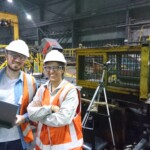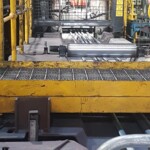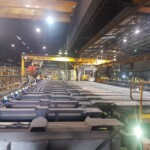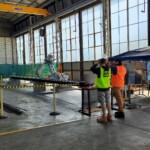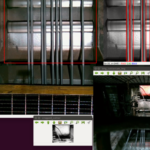InfraBuild had a number of reasons for partnering with the Australian Cobotics Centre:
- improving working conditions for employees,
- reducing fixed costs
- increasing customer satisfaction with improved quality
It was also important to them that any solutions we developed fit into the existing operations and did not require significant modification of their plants, processes and equipment. The Shorts Project is the first project we have developed with InfraBuild and the first project of the Centre.
Researchers from the Biomimic Cobots program are working with Infrabuild’s Sydney mill to research and develop a high speed sensing and control system that is capable of identifying the steel bars and coils and have the ability to be able to work safely within relative proximity of their operators.
Infrabuild’s production line is unique, in that they produce a wide range of steel bars with different shapes and sizes. While this makes them unique capability-wise globally, current off-the-shelf solutions for automating this detection and removal process cannot deal with the variety of bars. Hence, our researchers and engineers are aiming to develop a flexible system using a Cobot with inbuilt and external sensors that shifts away from traditional automation approaches and can adapt to the different steel bars that they manufacture – even new ones in the future – while working safely around workers.
The project had three distinct phases of work to prove that a cobot could complete the task:
- The identification of the shortest bar in the group via an automated system
- The use of a cobot to remove the bar from a moving conveyor belt
This will result in better working conditions for employees who will now operate the cobot instead of complete the tasks, and a more accurate and efficient identification process, resulting in higher quality products for their customers.
The project also includes the contributions of the Centre’s Engineers from QUT’s REF group.
Benefits
- providing safer working environment for their staff by removing humans from the dangerous part of the process
- potential for higher production efficiency as the system can run at all hours
Impact
-
Validation of Cobotic Capabilities
The proof of concept has successfully tested the ability of vision-guided cobots to identify, manipulate, and process steel components with precision. These findings lay the groundwork for future development and potential full-scale deployment in manufacturing environments. -
Workplace Safety & Operator Support
By demonstrating the potential for cobots to take on repetitive and physically demanding tasks, this project highlights a pathway to improved worker safety and reduced strain-related injuries, while enabling operators to focus on higher-value tasks. -
Insights for Industry Adoption
The project provides key learnings on the technical and operational challenges of integrating cobots in steel manufacturing, offering industry partners a clearer understanding of the next steps required for successful implementation. -
Pathway to Future Automation
As a proof of concept, this initiative establishes a foundation for further research and investment in cobotics, not just in relation to this specific activity. The findings will help InfraBuild in determining whether to continue to explore future iterations of the solution and if so, guide the development of a fully commercial solution by an integrator.
This proof-of-concept project, a collaboration between the Australian Cobotics Centre and InfraBuild, demonstrates the potential of vision-guided collaborative robots (cobots) in steel manufacturing. By exploring how cobots can handle steel components with greater precision and adaptability, the project provides critical insights into the feasibility of integrating advanced automation in the industry.
Project Team
- Andrew Thomas, InfraBuild
- Mark Christianson, InfraBuild
- Fred Sukkar, Australian Cobotics Centre Postdoctoral Research Fellow (UTS)
- Dasun Gunasinghe, Australian Cobotics Centre Lead Engineer (QUT)
- Gavin Suddrey, Australian Cobotics Centre Engineer (QUT)
- Teresa Vidal-Calleja, Australian Cobotics Centre Research Program Lead (UTS)
- Jonathan Roberts, Australian Cobotics Centre Director
Associated Researchers
